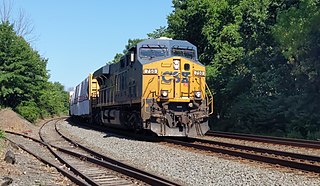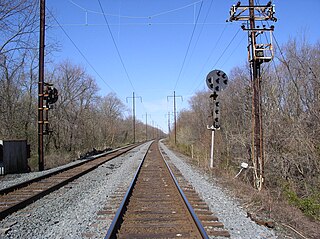
The Delaware, Lackawanna and Western Railroad, also known as the DL&W or Lackawanna Railroad, was a U.S. Class 1 railroad that connected Buffalo, New York, and Hoboken, New Jersey, and by ferry with New York City, a distance of 395 miles (636 km). Incorporated in Pennsylvania in 1853 primarily for the purpose of providing a connection between the anthracite coal fields of Pennsylvania's Coal Region and the large markets for coal in New York City. The railroad gradually expanded both East and West, eventually linking Buffalo with New York City.
The Lehigh Valley Railroad was a railroad built in the Northeastern United States to haul anthracite coal from the Coal Region in Pennsylvania. The railroad was authorized on April 21, 1846, for freight and transportation of passengers, goods, wares, merchandise, and minerals in Pennsylvania and the railroad was incorporated and established on September 20, 1847, as the Delaware, Lehigh, Schuylkill and Susquehanna Railroad Company.
Conrail Shared Assets Operations (CSAO) is the commonly used name for modern-day Conrail, an American railroad company. It operates three networks, the North Jersey, South Jersey/Philadelphia, and Detroit Shared Assets Areas, where it serves as a contract local carrier and switching company for its owners, CSX Transportation and the Norfolk Southern Railway. When most of the former Conrail's track was split between these two railroads, the three shared assets areas were kept separate to avoid giving one railroad an advantage in those areas. The company operates using its own employees and infrastructure but owns no equipment outside MOW equipment.

The Lehigh and Hudson River Railway (L&HR) was the smallest of the six railroads that were merged into Conrail in 1976. It was a bridge line running northeast–southwest across northwestern New Jersey, connecting the line to the Poughkeepsie Bridge at Maybrook, New York with Easton, Pennsylvania, where it interchanged with various other companies.
The Lehigh and New England Railroad was a Class I railroad located in Northeastern United States that acted as a bridge line. It was the second notable U.S. railroad to file for abandonment in its entirety after the New York, Ontario and Western Railway. It was headquartered in Philadelphia.
The Belvidere-Delaware Railroad was a railroad running along the eastern shore of the Delaware River from Trenton, New Jersey north via Phillipsburg, New Jersey to the small village of Manunka Chunk, New Jersey. It became an important feeder line for the Lehigh Valley Railroad's join to the Central Railroad of New Jersey, which was constructed into Phillipsburg, NJ at about the same time. This connected Philadelphia and Trenton, NJ at one end of the shortline railroad to the rapidly growing lower Wyoming Valley region, and via the Morris Canal or the CNJ, a slow or fast connection to New York City ferries crossing New York Harbor from Jersey City, NJ. In 1871 the CNJ leased various railroads in Pennsylvania, most from the Lehigh Coal & Navigation Company allowing the CNJ to penetrate to the upper Wyoming Valley, over some stretches, competing directly with the Lehigh Valley Railroad and with the Lehigh Canal and the trunk road connection of the Belvidere Delaware Railroad to New York became less profitable since Philadelphia connected more easily to Northeastern Pennsylvania thereafter without needing a double-crossing of the Delaware River; a general revenue decline ensued, leading to the Pennsylvania Railroad acquiring the rights, where it served as part of the Pennsylvania Railroad (PRR) system, carrying mainly anthracite coal and iron ore from northeastern Pennsylvania to population centers along the coast.

The Finger Lakes Railway is a Class III railroad in the Finger Lakes region of New York. The company began operations on July 23, 1995, and operates in Onondaga, Cayuga, Seneca, Ontario, Schuyler and Yates counties. The FGLK operates 18 diesel locomotives on 167 miles (269 km) of ex-Conrail trackage, formerly owned by the New York Central Railroad, the Pennsylvania Railroad and the Lehigh Valley Railroad. Between 2001 and 2013, the railroad operated a heritage railroad known as the Finger Lakes Scenic Railway which offered passenger train excursions.

The Conrail Lehigh Line is a railroad line in New Jersey that is part of Conrail Shared Assets Operations under the North Jersey Shared Assets Area division. The line runs from CP Port Reading Junction in Manville to Oak Island Yard in Newark. The line is double-track and signaled through its entire length. The line began operations in 1999 using former existing tracks from Manville to Newark that was once part of the original Lehigh Line which is still in existence and is owned and operated by Norfolk Southern Railway.

The Shamokin Valley Railroad is a short line railroad that operates 27 miles of track in southern Northumberland County, Pennsylvania in the United States. It is part of the North Shore Railroad System.

The Reading Blue Mountain and Northern Railroad, sometimes shortened to Reading and Northern Railroad, is a regional railroad in eastern Pennsylvania. Its headquarters is in Port Clinton. The RBMN provides freight service on 400 miles (640 km) of track. Its mainline consists of the Reading Division between Reading and Packerton and the Lehigh Division between Lehighton and Dupont. Its main freight cargo is anthracite coal.

The Trenton Subdivision is a railroad line owned by CSX Transportation in the U.S. states of Pennsylvania and New Jersey. The line runs from CP NICE in Philadelphia, Pennsylvania, northeast to Port Reading Junction in Manville, New Jersey, along a former Reading Company line.

The Harrisburg Line is a rail line owned and operated by the Norfolk Southern Railway (NS) in the U.S. state of Pennsylvania. The line runs from Philadelphia west to Harrisburg.

The Enola Branch is a railroad segment of the Port Road Branch and was a rail line. The Enola Branch railroad segment and the rest of the Port Road Branch is owned and operated by the Norfolk Southern Railway in the U.S. state of Pennsylvania. The railroad segment runs from Washington Boro northwest to Marysville and it is a former Pennsylvania Railroad rail line. Its south end is at a former junction with the Atglen and Susquehanna Branch, where the main segment of the Port Road Branch continues southeast. Its north end is at the Pittsburgh Line. Along the way, it meets the York Secondary at Wago Junction and goes under the Lurgan Branch at Lemoyne. Norfolk Southern labels the Enola Branch as part of the Port Road Branch, officially ending the Enola Branch's existence as a rail line, the main segment of the Port Road Branch runs from Marysville south to Perryville, Maryland. The line goes through the Enola Yard.

The Schuylkill Branch was a rail line owned and operated by the former Pennsylvania Railroad (PRR) in Pennsylvania. The line ran from the Philadelphia to Harrisburg Main Line at 52nd Street in Philadelphia north via Norristown, Reading, and Pottsville to Delano Junction, about 2.5 mi (4.0 km) northeast of Delano. From Delano Junction, the PRR had trackage rights over the Lehigh Valley Railroad's Hazleton Branch and Tomhicken Branch to Tomhicken, where the PRR's Catawissa Branch began.

The Lehigh Gorge Trail is a 26-mile (42 km) multi-use rail trail that winds along the valley of the Lehigh River Gorge from White Haven, to Jim Thorpe, Pennsylvania. Much of the trail runs through the Lehigh Gorge State Park, and was originally developed into a railroad corridor after an extension of the Lehigh Canal was first built under the great push of Main Line of Public Works to connect the Delaware Valley to Pittsburgh.

The Lehigh Gap or Lehigh Water Gap is a water gap located in the townships of Lehigh, Washington, Lower Towamensing, and East Penn in the Lehigh Valley and Coal Region regions of eastern Pennsylvania. It was formed by the Lehigh River, where it cuts through the Blue Mountain in Pennsylvania.

Duryea Yard is a railroad yard in the Wyoming Valley region of Northeastern Pennsylvania currently operated by the Reading Blue Mountain and Northern Railroad. Originally constructed in 1870 by Lehigh Valley Railroad as a turn-around and staging hub for coal transport from the Coal Region to Eastern big-city markets, the yard remains a hub for the energy extraction industry today.
The Lehigh Railway is a shortline railroad in Wyoming County and Bradford County, Pennsylvania. It connects to the Reading Blue Mountain and Northern Railroad in Mehoopany and to Norfolk Southern in Athens, just south of Sayre. It operates a total of 56 miles of track along the Susquehanna River. Since 2020, the railroad has been operated by the R.J. Corman Railroad Group as its Lehigh Line.

Mountain Top yard or Penobscot yard is a rail yard in Mountain Top, Pennsylvania. It was built by the Lehigh Coal & Navigation Company (LC&N) in response to an 1837 bill authorizing a right of way and was established by 1840, at least as a construction camp for the Ashley Planes, in support of the construction of the Lehigh and Susquehanna Railroad trackage and operations to join the northern Anthracite Coal Region from barge loading docks along the Susquehanna in Pittston, in the Wyoming Valley, with the Lehigh Canal.

The Lehigh Line is a railroad line in Central New Jersey, Northeastern Pennsylvania, and the Lehigh Valley region of eastern Pennsylvania. It is owned and operated by the Norfolk Southern Railway. The line runs west from the vicinity of the Port of New York and New Jersey in Manville, New Jersey via Conrail's Lehigh Line to the southern end of Wyoming Valley's Coal Region in Lehigh Township, Pennsylvania.














